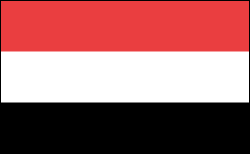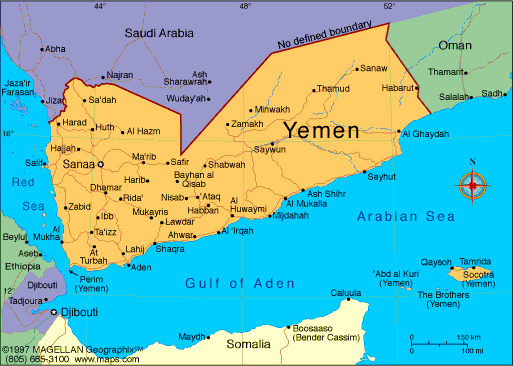YEMEN

Geography: Formerly divided into two nations, the People's Democratic Republic of Yemen and the Yemen Arab Republic, the Republic of Yemen occupies the southwest tip of the Arabian Peninsula on the Red Sea opposite Ethiopia and extends along the southern part of the Arabian Peninsula on the Gulf of Aden and the Indian Ocean. Saudi Arabia is to the north and Oman is to the east. The country is about the size of France. A 700-mile (1,130-km) narrow coastal plain in the south gives way to a mountainous region and then a plateau area.
Government: Parliamentary republic.
History: The history of Yemen dates back to the Minaean (1200–650 B.C. ) and Sabaean (750–115 B.C. ) kingdoms. Ancient Yemen (centered around the port of Aden) engaged in the lucrative myrrh and frankincense trade. It was invaded by the Romans (1st century A.D. ) as well as the Ethiopians and Persians (6th century A.D. ). In A.D. 628 it converted to Islam and in the 10th century came under the control of the Rassite dynasty of the Zaidi sect, which remained involved in North Yemeni politics until 1962. The Ottoman Turks nominally occupied the area from 1538 to the decline of their empire in 1918.
The northern portion of Yemen was ruled by imams until a pro-Egyptian military coup took place in 1962. The junta proclaimed the Yemen Arab Republic, and after a civil war in which Egypt's Nasser and the USSR supported the revolutionaries and King Saud of Saudi Arabia and King Hussein of Jordan supported the royalists, the royalists were finally defeated in mid-1969.
The southern port of Aden, strategically located at the opening of the Red Sea, was colonized by Britain in 1839, and by 1937, with an expansion of its territory, it was known as the Aden Protectorate. In the 1960s the Nationalist Liberation Front (NLF) fought against British rule, which led to the establishment of the People's Republic of Southern Yemen on Nov. 30, 1967. In 1979, under strong Soviet influence, the country became the only Marxist state in the Arab world.
The Republic of Yemen was established on May 22, 1990, when pro-Western Yemen and the Marxist Yemen Arab Republic merged after 300 years of separation to form the new nation. The poverty and decline in Soviet economic support in the south was an important incentive for the merger. The new president, Ali Abdullah Saleh, was elected by the parliaments of both countries.
Government: Parliamentary republic.
History: The history of Yemen dates back to the Minaean (1200–650 B.C. ) and Sabaean (750–115 B.C. ) kingdoms. Ancient Yemen (centered around the port of Aden) engaged in the lucrative myrrh and frankincense trade. It was invaded by the Romans (1st century A.D. ) as well as the Ethiopians and Persians (6th century A.D. ). In A.D. 628 it converted to Islam and in the 10th century came under the control of the Rassite dynasty of the Zaidi sect, which remained involved in North Yemeni politics until 1962. The Ottoman Turks nominally occupied the area from 1538 to the decline of their empire in 1918.
The northern portion of Yemen was ruled by imams until a pro-Egyptian military coup took place in 1962. The junta proclaimed the Yemen Arab Republic, and after a civil war in which Egypt's Nasser and the USSR supported the revolutionaries and King Saud of Saudi Arabia and King Hussein of Jordan supported the royalists, the royalists were finally defeated in mid-1969.
The southern port of Aden, strategically located at the opening of the Red Sea, was colonized by Britain in 1839, and by 1937, with an expansion of its territory, it was known as the Aden Protectorate. In the 1960s the Nationalist Liberation Front (NLF) fought against British rule, which led to the establishment of the People's Republic of Southern Yemen on Nov. 30, 1967. In 1979, under strong Soviet influence, the country became the only Marxist state in the Arab world.
The Republic of Yemen was established on May 22, 1990, when pro-Western Yemen and the Marxist Yemen Arab Republic merged after 300 years of separation to form the new nation. The poverty and decline in Soviet economic support in the south was an important incentive for the merger. The new president, Ali Abdullah Saleh, was elected by the parliaments of both countries.

Map of Yemen
President: Abdel Rabbo Mansour Hadi (2012)
Prime Minister: Khaled Bahah (2014)
Total area: 203,849 sq mi (527,969 sq
km)
Population (2014 est.):
26,052,966 (growth rate: 2.72%); birth rate: 31.02/1000; infant
mortality rate: 50.41/1000; life expectancy: 64.83; density per sq mi:
115.7
Capital and largest city (2011
est.): Sanaá, 2.419 million
Other large cities: Aden, 784,000;
Tiaz, 596,672; Hodiedah, 548,433
Monetary unit: Rial
Republic of Yemen
National name: Al-Jumhuriyah
al-Yamaniyah
Language: Arabic
Ethnicity/race: predominantly Arab; but also Afro-Arab, South Asians, Europeans
Religions:
Islam 99.1% (official; virtually all are citizens, an estimated
65% are Sunni and 35% are Shia), other 0.9% (includes Jewish, Baha'i,
Hindu, and Christian; many are refugees or temporary foreign residents)
(2010 est.)
Literacy
rate: 65.3% (2011 est.)
Economic
summary: GDP/PPP (2013 est.): $61.63 billion; per capita
$2,500. Real growth rate: 3.8%. Inflation: 11.8%.
Unemployment: 35% (2003 est.). Arable land: 2.2%.
Agriculture: grain, fruits, vegetables, pulses, qat, coffee,
cotton; dairy products, livestock (sheep, goats, cattle, camels),
poultry; fish. Labor force: 7.1 million (2013 est.); most people are
employed in agriculture and herding; services, construction, industry,
and commerce account for less than one-fourth of the labor force.
Industries: crude oil production and petroleum
refining; small-scale production of cotton textiles, leather goods;
food processing; handicrafts; aluminum products; cement; commercial ship
repair; natural gas production. Natural resources: petroleum, fish,
rock salt, marble, small deposits of coal, gold, lead, nickel, copper,
fertile soil in west. Exports: $6.694 billion (2013
est.): crude oil, coffee, dried and salted fish, liquefied natural gas. Imports:
$10.97 billion (2013 est.): food and live animals,
machinery and equipment, chemicals. Major trading partners:
Thailand, China, UAE, India,
South Korea, Switzerland, EU (2013).
Communications:
Telephones: main lines in use: 1.1 million (2012); mobile cellular:
13.9 million (2012). Radio broadcast stations:
state-run TV with 2 stations; state-run radio with 2 national radio
stations and 5 local stations; stations from Oman and Saudi Arabia can
be accessed (2007). Radios: 1.05 million (1997). Television broadcast
stations: 7 (plus several low-power repeaters) (1997).
Televisions: 470,000 (1997). Internet Service Providers
(ISPs): 33,206 (2012). Internet users: 2.349 million (2009).
Transportation: Railways: 0 km.
Highways: total: 71,300 km ; paved: 6,200 km; unpaved: 65,100
km (2005 est.). Ports and harbors: Aden, Al Hudaydah, Al
Mukalla, As Salif, Ras Issa, Mocha, Nishtun. Airports: 57
(2013).
International disputes:
Saudi Arabia has reinforced its concrete-filled security barrier
along sections of the fully demarcated border with Yemen to stem
illegal cross-border activities.
-------------------- o --------------------
No comments:
Post a Comment